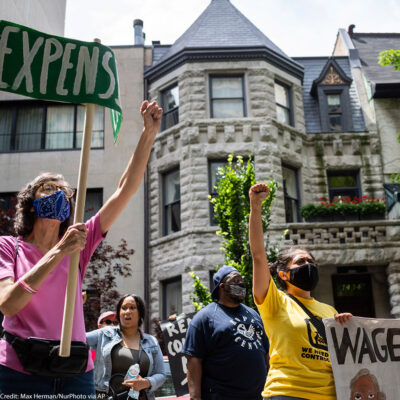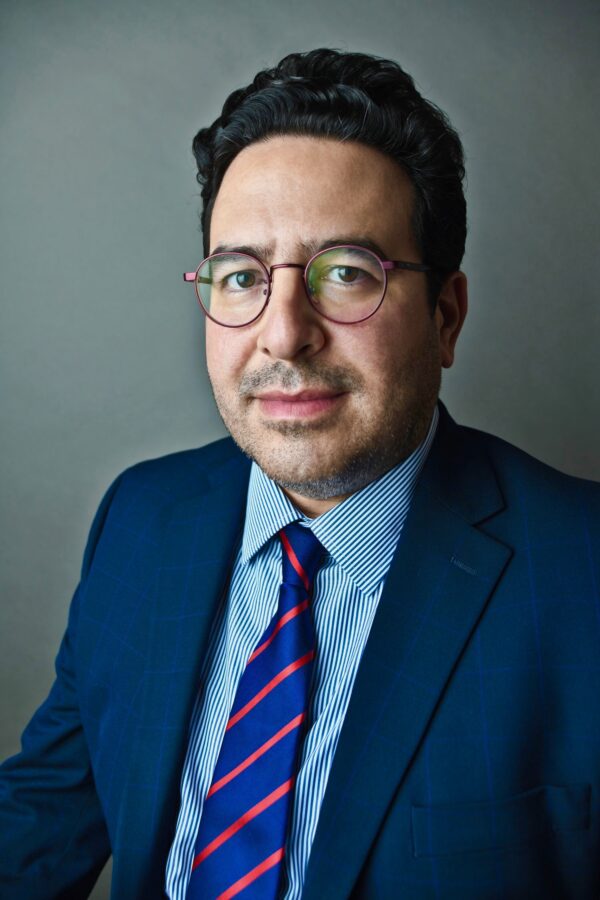
The Consequences of Chicago’s Segregated Housing History
May 18, 2023
Today, we're focusing on Chicago — the country's third largest (and one of the most diverse) cities, and a city that has been a blueprint for housing segregation. While the discriminatory practice of racial redlining was officially outlawed in 1968, the practice still reverberates throughout the city today. For every dollar loaned by banks in Chicago’s white neighborhoods, they invest just 12 cents in the city’s Black neighborhoods, and 13 cents in Latino areas, according to a 2020 study by WBEZ and City Bureau. A typical household’s wealth in the richest area of Chicago is 206 times higher than a typical household’s wealth in the poorest area. This continued inequity lies at the crux of the city’s ongoing struggles against gun and gang violence, unemployment, and homelessness, but are often overlooked. The system was designed to create these problems, and has worked as intended. Now, it’s time to learn how so many Chicagoans were set up to struggle, and how we can all be a part of undoing the legacy of racism that pervades the city’s maps.
Here to talk to us about Chicago’s infamous housing history, ongoing consequences, and nationwide influence, is Mike Amezcua, associate history professor at Georgetown University and author of “Making Mexican Chicago: From Postwar Settlement to the Age of Gentrification.”
In this episode
Kendall Ciesemier

This Episode Covers the Following Issues
Related Content
-
Press ReleaseDec 2025

Disability Rights
Women's Rights
Civil Rights Groups Urge Appeals Court To Order Timely Benefits Review For Survivors Of Military Sexual Trauma. Explore Press Release.Civil Rights Groups Urge Appeals Court to Order Timely Benefits Review for Survivors of Military Sexual Trauma
WASHINGTON – Four organizations advocating for the civil rights of survivors of military sexual trauma (MST) filed a friend-of-the-court brief today urging the U.S. Court of Appeals for the Federal Circuit to reverse a lower court decision denying expedited adjudication of veterans’ benefits to people with mental health disabilities arising from sexual violence in the military. The organizations filing the amicus brief, the National Alliance to End Sexual Violence, Protect Our Defenders Foundation, Service Women’s Action Network (SWAN), and the Victim Rights Law Center, are represented by the American Civil Liberties Union. “Survivors of military sexual trauma have already endured profound harm in service to our country, it is an insult upon injury that they are being forced to endure years of bureaucratic delay to receive the benefits Congress expressly promised them,” said Josh Connolly, senior vice president of Protect Our Defenders Foundation. “Congress was unequivocal when it passed the Dignity for MST Survivors Act: claims involving military sexual trauma must be expedited. Ignoring that mandate not only defies the law, it retraumatizes survivors and further undermines trust in the system meant to protect them.” In December 2022, Congress passed legislation requiring the Department of Veterans Affairs (VA) to improve its treatment of MST survivors, including the Dignity for MST Survivors Act which mandates the VA to expedite administrative appeals involving MST. Yet the U.S. Court of Appeals for Veterans Claims ruled in a case brought by Karissa Wiggins that it would not enforce this duty. “Survivors of military sexual trauma experienced the violence while in service to our country,” said Stacy Malone, executive director of Victim Rights Law Center. “It is unconscionable that victims are being denied timely access to benefits that would help them heal and rebuild their lives.” The brief explains that timely access to benefits is critical for veterans with disabilities stemming from MST, affording survivors who require costly treatment or are unable to work the financial support they need. It also explains that expedited adjudication and appeals encourage survivors to report MST and is consistent with Congress’ intent to make compensation for survivors more readily available. “Congress passed the Dignity for MST Survivors Act nearly unanimously with a crystal-clear mandate: to improve the treatment of victims of military sexual trauma. By denying prompt review of these claims, our government is breaking the promise Congress made to care for those who have served,” said Brad Adams, senior staff attorney with the ACLU Disability Rights Program. Finally, the brief highlights that women and LGBTQ veterans are overrepresented among survivors, bearing the brunt of a dysfunctional claims process, while stigma and implicit biases infect the claims of men and Black veterans, who are more likely to have their claims denied. “Timely access to benefits can be the difference between stability and crisis for survivors of military sexual trauma. Congress recognized this reality when it required expedited review of MST claims. Failing to enforce that law undermines both survivor dignity and congressional intent,” said SWAN’s CEO and President Elisa Cardnell. The brief is available here: https://www.aclu.org/cases/karissa-wiggins-v-douglas-collins?document=Amicus-BriefCourt Case: Karissa Wiggins v. Douglas Collins -
Court CaseDec 2025

Disability Rights
Women's Rights
Karissa Wiggins V. Douglas Collins. Explore Case.Karissa Wiggins v. Douglas Collins
-
Press ReleaseNov 2025

LGBTQ Rights
Women's Rights
Transgender West Virginia Teen Challenges Athletic Ban At Supreme Court. Explore Press Release.Transgender West Virginia Teen Challenges Athletic Ban at Supreme Court
WASHINGTON – Attorneys representing a 15-year-old West Virginia transgender girl, Becky Pepper-Jackson, and her mother Heather Jackson today filed their response brief to the Supreme Court of the United States in their challenge to a 2021 West Virginia law barring Pepper-Jackson from participating on girl’s athletic teams. Becky and her mother are represented in West Virginia v. B.P.J by the American Civil Liberties Union, the ACLU of West Virginia, Lambda Legal, and Cooley LLP. “I play for my school for the same reason other kids on my track team do–to make friends, have fun, and challenge myself through practice and teamwork,” said Becky Pepper-Jackson, 15, of West Virginia. “And all I’ve ever wanted was the same opportunities as my peers. Instead, I’ve had my rights and my life debated by politicians who’ve never even met me but want to stop me from playing sports with my friends. I know this case isn’t just about me, or even just about sports. It’s just one part of a plan to push transgender people like me out of public life entirely. I’m proud to stand up alongside my mom for what I believe and who I am and I want other transgender kids to know they aren’t alone.” “I’ve always raised my children to stay true to themselves, no matter what anyone else tells them,” says Heather Jackson, mother of Becky Pepper-Jackson. “"I'm so proud of Becky and the young woman she's becoming, one who is hardworking, kind, and a team player. My daughter and every transgender kid like her deserves the freedom to be themselves and a future where no one is discriminated against just because of who they are.” “This case is fundamentally about the ability of transgender youth like Becky to participate in our schools and communities,” said Joshua Block, Senior Counsel for the ACLU’s LGBTQ & HIV Project. “School athletics are fundamentally educational programs, but West Virginia’s law completely excluded Becky from her school’s entire athletic program even when there is no connection to alleged concerns about fairness or safety. As the lower court recognized, forcing Becky to either give up sports or play on the boy’s team–in contradiction of who she is at school, at home, and across her life–is really no choice at all. We look forward to defending her rights, and the rights of every young person, to be included as a member of their school community, at the Supreme Court.” “Becky simply wants to be with her teammates on the track and field team, to experience the camaraderie and many documented benefits of participating in team sports,” said Lambda Legal Counsel, Nonbinary & Trans Rights Project Director, Sasha Buchert. “It has been amply proven that participating in team sports equips youth with a myriad of skills – in leadership, teamwork, confidence, and health. On the other hand, denying a student the ability to participate is not only discriminatory, but harmful to a student’s self-esteem, sending a message that they are not good enough and deserve to be excluded. In the end, can we not just let the kids play?” The Supreme Court has also agreed to hear Little v. Hecox, a challenge brought by a transgender student against Idaho’s 2020 ban on transgender athletes and requirements for sex testing. The American Civil Liberties Union, the ACLU of Idaho, Legal Voice, and Cooley LLP represent the plaintiffs in this case. The two cases charge the bans with violating the rights of transgender and cisgender female students under the Equal Protection Clause of the Fourteenth Amendment of the U.S. Constitution. In addition, West Virginia v. B.P.J. argues that the bans violate Title IX, the federal law prohibiting sex discrimination in educational programs. Federal courts have blocked enforcement of these bans in both lawsuits. Since 2020, 27 states have banned transgender youth from playing school sports. Many of these bans allow for invasive forms of sex testing that put all female student-athletes at risk and embolden intrusive challenges to student athletes' sex. In Florida, a 15-year-old junior varsity volleyball player was the subject of a police investigation after an anonymous accusation, prompting local officials to draft a 500-page report investigating her medical history, body weight, and anatomy. In Utah, a teenage basketball player was accused of being transgender by a member of the state board of education, leading to threats of violence against her and her family, and a teenager in Maine faced a similar attack from a state senator. In May, President Donald Trump similarly targeted a 16-year-old transgender girl for participating in a high school track meet. Under an Arizona ban, a cisgender male student was prohibited from participating on the boy’s team at his high school because of a clerical error that listed him as female on his original birth certificate. Many women athletes have spoken out against bullying and discrimination against transgender student-athletes, including Billie Jean King, Megan Rapinoe, Dawn Staley, Sue Bird, and Brianna Turner, as well as leading organizations fighting for gender equality in athletics including the Women’s Sports Foundation, the Women’s National Basketball Player’s Association, and the National Women’s Law Center. Today's brief in West Virginia v. B.P.J. can be found here. Today's brief in Little v. Hecox can be found here. These cases are part of the ACLU’s Joan and Irwin Jacobs Supreme Court Docket.Court Case: West Virginia v. B.P.J.Affiliates: West Virginia, Idaho -
News & CommentaryOct 2025

Women's Rights
Pete Hegseth Wants Women Out Of The Military—and He's Not Hiding It. Explore News & Commentary.Pete Hegseth Wants Women Out of the Military—and He's Not Hiding It
From disbanding a gender advisory board to misrepresenting women’s ability to meet combat standards, the defense secretary’s record shows a clear mission: push women out of service.By: Gillian Thomas
